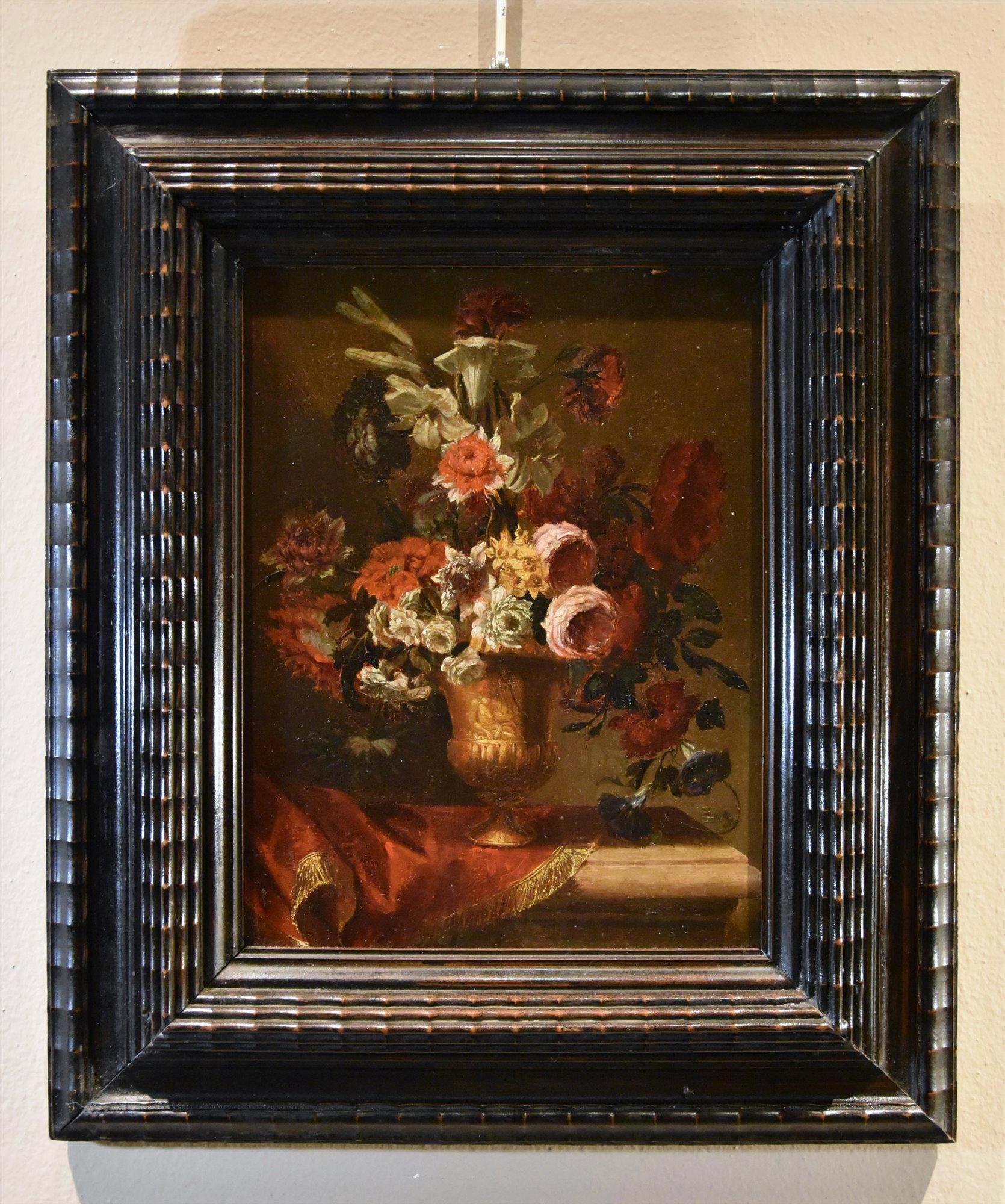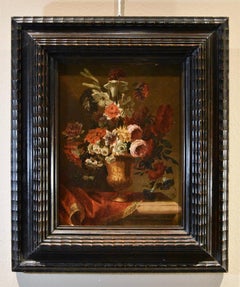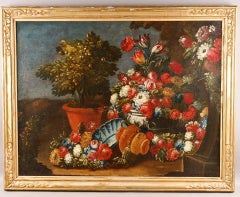Items Similar to Still Life Garland of Flowers - Flemish 18thC art Old Master floral oil painting
Want more images or videos?
Request additional images or videos from the seller
1 of 16
Still Life Garland of Flowers - Flemish 18thC art Old Master floral oil paintingCirca 1730
Circa 1730
$19,734.06
$24,667.5720% Off
£14,400
£18,00020% Off
€16,799.94
€20,999.9220% Off
CA$27,030.73
CA$33,788.4120% Off
A$30,064.07
A$37,580.0820% Off
CHF 15,698.52
CHF 19,623.1520% Off
MX$365,847.72
MX$457,309.6620% Off
NOK 200,494.08
NOK 250,617.6020% Off
SEK 188,028.08
SEK 235,035.0920% Off
DKK 125,384.38
DKK 156,730.4820% Off
Shipping
Retrieving quote...The 1stDibs Promise:
Authenticity Guarantee,
Money-Back Guarantee,
24-Hour Cancellation
About the Item
This superb 18th century Old Master floral still life oil painting is attributed to Flemish artist Pieter Casteels III. Painted circa 1730 it is a garland or swag of flowers, something Casteels often painted to be hung above a doorway. The garland is depicted tied with bows to two brass rings on hooks. As a nod to the passage of time or memento mori the flowers are all fully opened and the central tulip about to drop its petals. The dramatic reds and white stands out well against the dark background. A fantastic 18th century Flemish still life.
Provenance. Wiltshire estate.
Christies details verso.
Condition. Oil on canvas, 39 inches by 15 inches and in good condition.
Frame. Housed in a gallery frame, 46 inches by 22 inches and in good condition.
Pieter Casteels III (1684–1749) was a Flemish painter and engraver mainly known for his flower pieces, game pieces and bird scenes. He spent a significant portion of his life in England where he had a varied career as a still life painter, printmaker and textile designer. Pieter Casteels III was born in Antwerp as the son of Elisabeth Bosschaert and Pieter Casteels II, a painter of landscapes and history paintings. He trained with his father. In 1708 he left with his brother-in-law Peter Tillemans to England to work for a picture dealer named Turner for whom they made copies of Old Master paintings. Casteels became an active participant in London's artistic community, subscribing to the Kneller Academy of Painting and Drawing in 1711 and becoming a member of the Rose and Crown Club. He returned briefly to Antwerp in 1712 where he became a member of the local Guild of Saint Luke in the same year. Casteels settled permanently in England around 1717. He developed a successful practice as a painter of flowers and exotic birds that chiefly served a decorative purpose as overdoors and chimneypieces. He worked simultaneously as an art dealer and imported paintings from Europe. His customers included James Stanley, 10th Earl of Derby who bought imported art as well as original work of Casteels. In 1726 Casteels launched a subscription for a set of 12 prints of birds, which he had etched after his own designs. The success of this project encouraged him to work on two further publications: the Twelve Months of Flowers and the Twelve Months of Fruit. Casteels advertised the usefulness of the illustrations in these publications as patterns for workers in luxury industries. Casteels was thus able to demonstrate his potential as a textile designer. In May 1735 he retired from painting and spent his last fourteen years working for a calico manufacturer as a residential artist, first at Martin Abbey near Tooting, Surrey, and later, briefly, in Richmond, London. Casteels painted flowers, flower pieces, landscapes, bird scenes, game pieces and occasional portraits. He is often confused with Peter Frans Casteels, a still life painter active in Antwerp in the late 17th century. Some of his animal scenes show similarity with the style of Dutch master Melchior d'Hondecoeter and in some cases experts have been unable to determine whether to attribute a particular work to either master. As he spent most of his active career in England, a large portion of his work is in public and private collections in the UK.
- Attributed to:Pieter Casteels III (1684 - 1729, Dutch)
- Creation Year:Circa 1730
- Dimensions:Height: 22 in (55.88 cm)Width: 46 in (116.84 cm)Depth: 2 in (5.08 cm)
- Medium:
- Movement & Style:
- Period:1730-1739
- Condition:
- Gallery Location:London, GB
- Reference Number:1stDibs: LU853113076552
About the Seller
5.0
Platinum Seller
Premium sellers with a 4.7+ rating and 24-hour response times
1stDibs seller since 2018
453 sales on 1stDibs
Typical response time: 1 hour
- ShippingRetrieving quote...Shipping from: London, United Kingdom
- Return Policy
Authenticity Guarantee
In the unlikely event there’s an issue with an item’s authenticity, contact us within 1 year for a full refund. DetailsMoney-Back Guarantee
If your item is not as described, is damaged in transit, or does not arrive, contact us within 7 days for a full refund. Details24-Hour Cancellation
You have a 24-hour grace period in which to reconsider your purchase, with no questions asked.Vetted Professional Sellers
Our world-class sellers must adhere to strict standards for service and quality, maintaining the integrity of our listings.Price-Match Guarantee
If you find that a seller listed the same item for a lower price elsewhere, we’ll match it.Trusted Global Delivery
Our best-in-class carrier network provides specialized shipping options worldwide, including custom delivery.More From This Seller
View AllFloral Arrangement in a Glass Vase - Dutch Old Master still life oil painting
By Simon Pietersz Verelst (circle)
Located in London, GB
This stunning 18th century Dutch Old Master Golden Age floral oil painting is attributed to a circle of Simon Pietersz Verelst. Painted circa 1720 it is a still life floral of a mixe...
Category
1720s Old Masters Still-life Paintings
Materials
Oil
$14,800 Sale Price
20% Off
Still Life of Flowers in Ornamental Urn on Ledge - Dutch Old Master oil painting
By Gerard van Spaendonck
Located in London, GB
This superb vibrant Dutch 18th century Old Master floral oil painting is attributed to circle of Gerard Van Spaendonck. Painted circa 1790, it is a beautiful mixed floral still life flower arrangement in an ornate urn on a marble ledge against a landscape. The flowers include roses, tulips, blue iris and trailing blue morning glory. The carved ornate grey/blue urn on the cream marble ledge create a strong textural contrast with the soft petals and leaves. This is a wonderful example of Dutch 18th century floral oil paintings with fine detail and brushwork.
Provenance. Private Collection, UK (by descent).
Condition. Oil on canvas, 30 inches by 25 inches unframed and in good condition.
Frame. Housed in an ebonised frame, 39 by 34 inches framed and in good condition.
Gerard van Spaendonck (1746-1822) was a Dutch painter. Gerard was born in Tilburg, an older brother of Cornelis van Spaendonck...
Category
1790s Old Masters Still-life Paintings
Materials
Oil
$9,867 Sale Price
20% Off
Still Life of Flowers and fruit - Dutch Old Master c1700 floral art oil painting
Located in London, GB
This superb Dutch Old Master floral still life oil painting is attributed to circle of Simon Pietersz Verelst. Painted circa 1700 the compositio...
Category
Early 1700s Old Masters Still-life Paintings
Materials
Oil
$7,674 Sale Price
20% Off
Mixed Floral Arrangement in a Vase - Dutch Old Master Golden Age oil painting
Located in London, GB
This stunning 18th century Dutch Old Master Golden Age floral oil painting is attributed to Simon Pietersz Verelst. Painted circa 1700 it is a still life floral of a mixed flower arr...
Category
Early 1700s Old Masters Still-life Paintings
Materials
Oil
Still Life of Flowers in vase on Ledge - Dutch 17thC Old Master art oil painting
Located in London, GB
This stunning 17th century Dutch Old Master Golden Age floral oil painting is by noted Dutch artist Simon Pietersz Verelst. The full attribution...
Category
1670s Old Masters Still-life Paintings
Materials
Oil
Floral Still Life in Basket - Franco Flemish art Old Master flower oil painting
Located in London, GB
This lovely 17th century Old Master floral oil painting is attributed to the circle of noted Franco Flemish artist Jean-Baptiste Monnoyer. Painted circa 1670 it is a still life of a ...
Category
17th Century Old Masters Still-life Paintings
Materials
Oil
You May Also Like
Still-Life Flowers 17th century Flemish School Paint Oil on table Old master
Located in Riva del Garda, IT
17th-century Flemish school
Still life with flowers
Oil on panel 33 x 25 cm In frame 50 x 42 cm
The painting depicts a wonderful still life of flowers, where numerous colour...
Category
17th Century Old Masters Paintings
Materials
Oil
Still-Life Flowers Ascione 17/18th Century Paint Oil on canvas Old master Italy
Located in Riva del Garda, IT
Aniello Ascione
(Naples, news from 1680 to 1708)
Still life with festoon of flowers and fruit
Oil painting on canvas
89 x 117 cm - in frame 104 x 132 cm.
With expertise and attrib...
Category
17th Century Old Masters Paintings
Materials
Oil
$18,566 Sale Price
20% Off
Flower Still-life Van Everbroeck Paint 17th Century Oil on canvas Old master Art
Located in Riva del Garda, IT
Frans van Everbroeck (Antwerp, ca. 1628 - London or Antwerp 1676/1693)
attributed
A stone cartouche surrounded by garlands of flowers with tulips, roses, daffodils, peonies and daisi...
Category
17th Century Old Masters Paintings
Materials
Oil
$11,837 Sale Price
20% Off
Huge 18th Century Italian Oil Still Life Classical Flowers Ornamental Setting
Located in Cirencester, Gloucestershire
Ornamental Flowers in a Classical Still Life Composition
Italian School, circa 1780's period
oil painting on canvas: 32 x 42 inches
antique gilt frame: 38 x 48 inches
condition: over...
Category
Late 18th Century Baroque Still-life Paintings
Materials
Canvas, Oil
Pieter Casteels III 'Signed' Floral Still Life Old master Paint 18th Century Art
By Pieter Casteels III (Antwerp 1684 - 1749 Richmond)
Located in Riva del Garda, IT
Pieter Casteels III (Antwerp 1684 - 1749 Richmond) circle
Floral still life
Signed lower left, on the stone: P Casteels
About 1730
Oil painting on...
Category
18th Century Old Masters Paintings
Materials
Oil
$15,420 Sale Price
40% Off
FLOWERS - Dutch School -Italian Still Life Oil on Canvas Painting
By Carlo De Tommasi
Located in Napoli, IT
Flowers - Carlo De Tommasi Italia 2008 - Oil on canvas cm. 90x60
In this painting Carlo De Tommasi is inspired by the eighteenth-century works of Abrham Bosschaert Dutch painter, kno...
Category
Early 2000s Dutch School Still-life Paintings
Materials
Canvas, Oil
More Ways To Browse
Used Life Rings
Antique Flower Art
Same Old
Flemish Masters
Still Life Game
Old Master Flemish
Antique Life Rings
Old Master Birds
Antique Brass Painting
Flemish Flower Painting
James Holland
Antique Bird Oil Painting
Memento Mori Art
18th Century Bird Painting
Floral Paintings 18th Century
Dark Floral Oil Painting
Floral And Birds Paintings
Month Flower Prints









